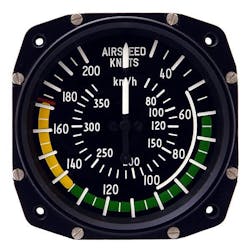ARLINGTON, Va. – U.S. military researchers are asking industry to develop new kinds of velocity sensors using localized processing that can realize precise force measurements with high dynamic range and controllable charge or mass modulation.
Officials of the U.S. Defense Advanced Research Projects Agency (DARPA) issued a solicitation on Friday (DARPA-PA-23-05-01) for the Velocimeter for Rapid Terrestrial Orienteering without human-made Reference (Veloci-RapTOR) project.
These velocity sensors would isolate the velocity-dependent force from all other potential clutter signals, and determine if force sensors can measure and isolate velocity-dependent forces, linked to the Earth reference frame, from the much larger platform forces or clutter.
Today's velocity sensors typically rely on a measurement external to the platform, including the presence of human-made reference signals such as the Global Positioning System (GPS); reflectometry methods like radar, lidar, and sonar; and flow measurements like Pitot tubes.
Physics does not allow for an absolute velocity; one only can take relative velocity measurements, which requires a measurement external to the platform, and is subject to noise and clutter.
A major challenge for velocity extraction is the relative magnitude of the minute velocity-dependent force compared to the much larger external forces experienced by the force sensor.
The Veloci-RapTOR program assumes that force sensors with modulated control, via charge or mass, can isolate the velocity-dependent signal from the background clutter.
Several different kinds of velocity force sensors exist today, such as atomic, ionic, and molecular sensors; cavity opto-mechanical systems; and micro-electromechanical systems (MEMS).
Veloci-RapTOR will capitalize on two well-known physical observations tied to the Earth reference frame: the Lorentz force and the Coriolis force.
The Lorentz force refers to an electrically charged particle moving in a known direction and speed through a magnetic field; ensembles of charges embedded or deposited within a substrate exhibit a current when the substrate moves relative to the fluxdirection of a magnetic field, such as in the Earth’s magnetic field lines.
The Coriolis force, meanwhile, relies on the Earth’s rotation and exhibits a force on something that moves at a given direction and speed relative to the Earth’s rotational vector. Exploitation of these forces will form the basis for Veloci-RapTOR’s force sensor measurements.
Veloci-RapTOR will explore several force measurement technologies. Challenges include isolation and dynamic range and sensitivity versus control.
Related: Joining sensors through data fusion
Contractors will establish their own force-transduction metrics to track progress towards meeting the program challenges. At a minimum, participants should demonstrate a force transduction mechanism consistent with velocity extraction; a control parameter in the force transduction measurement that enables isolation of the velocity-dependent force from all other forces; and a velocity measurement.
Companies interested should upload proposals no later than 7 May 2024 to the DARPA submission website at https://baa.darpa.mil.
Email questions or concerns to Jonathan Hoffman, the DARPA Veloci-RapTOR program manager, at [email protected]. More information is online at https://sam.gov/opp/c8a27fb1768541f68e7bf7eaf985b9ad/view.



